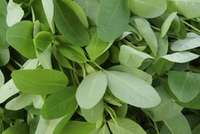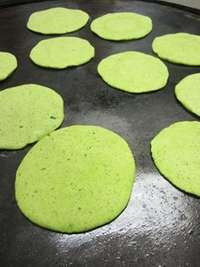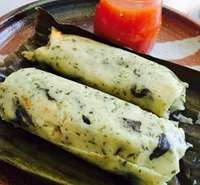
Figure 8. Chipilín leaves. Source: Andrea Guzmán Abril
Introduction
Chipilín (Crotalaria longirostrata; Figure 8) is native to southern Mexico and Central America. This species of Crotalaria is a popular food plant in countries such as Guatemala and El Salvador (Morton, 1994). It is probably the species of the genus Crotalaria most used as food. The young leaves and shoots are consumed, either alone or mixed with other foods. It grows in humid soils, open slopes, and is commonly planted in fields and gardens. 3
Additionally, as a legume, chipilín has a positive impact on soil fertility (Camarillo-Castillo and Mangan, 2020). Legumes, in conjunction with soil bacteria, convert nitrogen from the atmosphere into ‘fixed’ nitrogen that plants can uptake.

Figure 9. Tortillas made with chipilín. Source: Andrea Guzmán Abril
Nutrition
Chipilín leaves are highly nutritious (Table 3). They are an excellent source of calcium, iron, and vitamin A. Chipilín leaves are also rich in protein that is high in lysine (Bressani, 1983). Lysine is an amino acid that is essential to human health and deficient in corn protein. This makes chipilín a good protein supplement, increasing the nutritional quality of corn or other starch flour that the leaves are often prepared with (Figure 9).
| Protein (g) | 7.0 |
| Fat (g) | 0.8 |
| Carbohydrate (g) | 9 |
| Fiber (g) | 2.0 |
| Ashes (g) | 1.5 |
| Calcium (g) | 287 |
| Phosphorus (g) | 72 |
| Iron (g) | 4.7 |
| VItamin A (mcg) | 3,065 |
| Vitamin B1 (mg) | 0.33 |
| Bitamin B2 (mg) | 0.49 |
| Nacin (mg) | 2.0 |
| Vitamin C (mg) | 100 |
| Moisture (%) | 82 |
| Energy (cal) | 56 |
| From Leung and Flores (1961) | |
Culinary

Figure 10. Tamales with chipilín. Source: Andrea Guzmán Abril
The leaves have a very pleasant smell and taste. They give food a lot of flavor. Cook the leaves until they are soft. 4 Many preparations can be made. For example, the leaves can be prepared in stews or added to beans, eggs, or rice and beans. They are also consumed by mixing chipilín leaves with corn flour to create various preparations such as chipilín tamales (Figure 10). Children six months and older can consume the leaves, which are a dietary source of protein and vitamin A.
Seeds
Active development workers who are members of ECHOcommunity.org may request a trial packet of seed. (See the website for how to register as a member and how to order seeds.)
References
Bressani, R. 1983. World needs for improved nutrition and the role of vegetables and legumes. Asian Vegetable Research and Development Center, 10th Anniversary Monograph Series (83-185).
Camarillo-Castillo, F. and F.X. Mangan. 2020. Biological nitrogen fixation in chipilin (Crotalaria longirostrata Hook. & Arn.), a sustainable nitrogen source for commercial production. Revista Chapingo Serie Horticultura 26(2):125-141.
Leaf for Life. Crotalaria longirostrata. Accessed 2022-01-04. https://www.leafforlife.org/gen/crotolaria.html
Leung, W.T.W. and M. Flores. 1961. Food composition table for use in Latin America. US Government Printing Office.
Morton, J.F. 1994. Pito (Erythrina berteroana) and chipilin (Crotalaria longirostrata), (Fabaceae), two soporific vegetables of Central America. Economic Botany 48:130-138.
Tropical Plants Database, Ken Fern. tropical.theferns.info. Accessed 2022-01-04. tropical.theferns.info/viewtropical.php?id=Crotalaria+longirostrata
Resources in Spanish
- Baby recipes using chipilín: https://proyectocan.org/wp-content/uploads/2021/02/Recipe-book-Redesing-Jose-v2-1.pdf (Recipes with chipilín on page 13, 17 and 25)
- Videos with herbs: https://www.youtube.com/playlist?list=PLqITG81Uu_fCDmF8c6ia6fJUFkuB9qo8K
- Other free resources: www.proyectocan.org